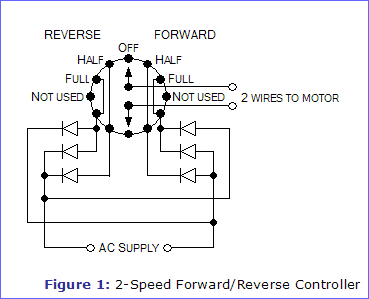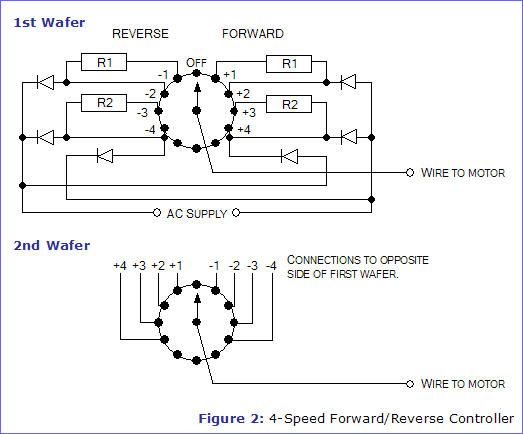
Rotary Switch Motor Controllers
By John Hewes
Described below are two motor controllers that can be built using the simplest of components – a rotary switch, diodes and resistors. The diodes and resistors can be soldered directly onto the tags of the rotary switches, avoiding the use of breadboard or stripboard.
This controller, shown in figure 1, must be powered from an AC supply and uses six diodes in an arrangement that allows the motor to rotate at half or full speed, in either the forward or reverse direction.

The rotary switch used is a 6-position type with two poles; but only five positions are needed for this controller. To set the number of positions, prise off the metal ring on the top of the switch with a screwdriver. You will see a legend from '2' to '5', so move the ring to the '5' position. Note that if you needed all 6 positions, you would leave the ring off permanently.

The controller in figure 2 is similar to the one described above, except that it uses resistors as well as diodes to provide extra speed settings. It also requires a 'wafer' switch to be used, so is slightly more complicated to assemble.
Resistors R1 and R2 must be chosen to suit the requirements of the motor to be controlled. The value of R1 should probably be the same as the value of R2, and for typical Meccano motors it would need to be between 5Ω and 25Ω. The resistors will need to be wire-wound and rated for high power – at least 3W and certainly more for medium sized motors.
Lamps such as torch bulbs (3.5V, 0.2A rating) could be used instead of the resistors – they have the advantage of a lower resistance when first switched on, giving the motor an initial surge of power to overcome inertia in the mechanism. This would be especially useful at the low speed settings (+1 and –1) where the motor may be reluctant to start despite running quite happily once it has started!

Wafer switches consist of several parts:

The top half of figure 2 shows the first of the wafers in the four-speed motor controller. One lead from the motor is connected to the common of this wafer, the other lead is connected to the common of the second wafer. Other connections to the second wafer are between it and the first wafer – connect a wire from contact +1 of the first wafer to contact –1 of the second wafer, a wire from contact +2 of the first wafer to contact –2 of the second wafer, etc. This is shown in the bottom half of figure 2.
Six diodes are required for each controller, although in fact one of these diodes could be omitted, but I think it is better left in to keep the design symmetric, reducing the chance of an error occurring – diodes are cheap after all! Use 1N4001 diodes for applications where the current will be under 1A, or 1N5401 diodes for currents up to 3A.
Article Information
Source: Electronics in Meccano - www.eleinmec.com
| First published in EiM: Issue 7 (April 2000)
Topic: Controlling Motors |
Created: 09/02/2007 |
Last modified: 02/10/2007
Top of Page | Homepage | About | Search | Topics | Features | Circuits Shop | yourEiM |
© 1998 - 2024 Tim Surtell |